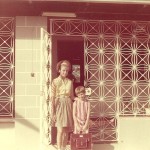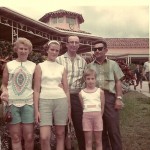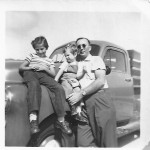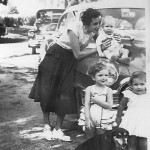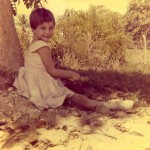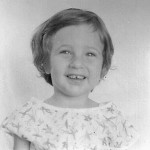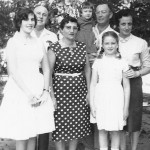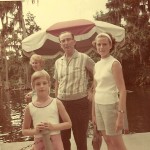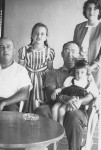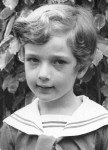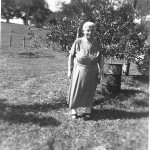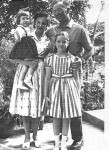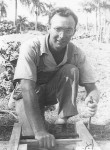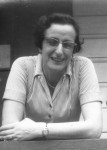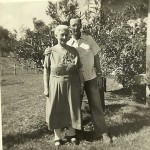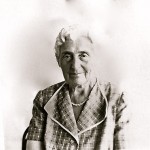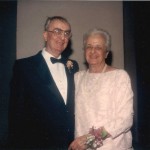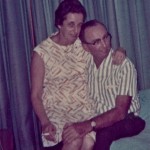| Paul Cohnen: | Born in Aldenhoven, Germany September 6, 1917 Deceased in Santo Domingo April 8, 2007 |
| Grete Cohnen nee Hausmann: | Born in Düren, Germany April 17, 1917 Deceased in Miami, US March 27, 1993 |
Children: Jeanette, Eva
FAMILY STORY:
Paul Cohnen was raised in the farming community of Aldenhoven, Germany during the interlude between world wars, and began his lifelong passion with dairy farming at an early age on his family’s farm. Along with his older brother Alfred, Paul was encouraged in his farming career by his loving parents, Max and Sara Cohnen.
Grete Cohnen nee Hausmann was born in Düren in 1917 to Hermann Hausmann and Jenny (Jeanette) Wolf. Her father died while she was still an infant, and she was raised by her mother Jenny, along with her older siblings Richard and Eva.
In the 1930s, the oncoming Nazi tide left none untouched, including Paul and Grete. During the infamous Kristallnacht (11/9/38), Paul and his brother Alfred were sent to Dachau prison (later to become a concentration camp). They were released three months later, and Paul went to work on a farm for a year.
Grete also saw the ominous signs, and left Germany in August 1939 via Holland. From there, she went to London, where she had previously procured a job as a housekeeper for a family who spoke German. Grete was then interned on the Isle of Man as a POW for a year because of her German nationality. Upon her release, she applied to and was accepted in a nursing program at a London hospital. She spent the last war years in London, first as a student and then as a registered nurse. At war’s end, Grete would learn that her beloved mother and sister perished in a concentration camp in Poland. In 1947, she left for the United States, where she worked as a nurse in Newark.
After the events of Kristallnacht, DORSA sent a representative to scout for refugees in Europe. They were looking for people they thought would make good settlers for the rigors of farming in Sosúa. Young people with agricultural backgrounds were highly sought after for the nascent refugee colony, and farming was an auspicious profession to be in. Paul’s dairy background would ensure he was selected for this venture. Through a variety of transports, he was able to leave Germany, eventually arriving in Genoa, Italy. Here he embarked on an epic journey to the new settlement, sailing on the Conte Biancamano with about fourteen other Sosúa-bound refugees.
On May 8, 1940 – a day that Paul observed with deep reflection every year – he arrived in Santo Domingo with the first group of settlers. From there, it was just another day’s travel by truck to Sosúa. Here he quickly became involved in dairy farming, and enjoyed adapting and improving the cattle herds for this tropical environment. “Pablo,” as Paul became known in Sosúa, helped produce some of the first butters and cheeses in the community. He and the other farmers would become instrumental in the success of the dairy and meat industry that Sosúa became famous for, Productos Sosúa.
It should be noted that Paul and Alfred’s father, Max, sadly had passed away in March 1941. His wife, and their mother, Sara was then barely able to leave Germany – via Lisbon, Portugal – on the very last ship to Sosúa from Europe before the bombing of Pearl Harbor in December 1941. It would be the end of the war before safe passage from Europe to Sosúa could be ensured once again.
At first Pablo lived in the barracks in the Batey, and eventually he moved to a house in Bombita with his mother Sara. The household expanded with the arrival of his bride, Grete, in 1951, and a couple of years later expanded again with the arrival of their first child, Jeany. By 1954, the family moved to the Batey, this time to Pedro Clisante Street. It was a wonderful location, directly across the street from Pablo’s brother Alfred and his family, who had come to Sosúa in 1949. For the Cohnen nieces, it meant being able to play and sleep at each other’s homes every day. Oma Sara was able to enjoy these last years of her life with the family, until she passed away in 1958. Another daughter, Eva, was born during this time in the Batey.
The families remained close throughout their years in Sosúa, celebrating Shabbat and holidays together whenever possible. A tradition of baking braided challah on Friday morning for the Sabbath developed, and both Grete and her sister-in-law (also named Grete) alternated making the wonderful, fragrant loaves. A delicious, festive meal, along with the appropriate Hebrew prayers and blessings, would help usher in the special day of rest for these families. Often friends would join in the celebration.
During the rest of the week, Grete would stay busy as a homemaker, applying her excellent cooking and baking skills for the benefit of her family and friends, much to their delight. She was very fond of handicrafts, including making some of her daughters’ clothes. Crocheted doilies, embroidered handkerchiefs, and macramé plant hangers were also favorite projects. In the early years in Sosúa, prior to having children of her own, Grete used her abundant nursing skills to help the town’s doctor with births, and would help treat patients for malaria and other illnesses.
Dairy farming has always been a labor-intensive profession, including in Sosúa, where milking was done by hand. Pablo would go the finca by 5 a.m., then again by mid-afternoon for the twice-daily milkings. He and the dairy hands had their work cut out for them, as there were cows to be milked, treated, branded, and a number of other jobs to attend to. Pablo would sometimes take along his children, much to their great delight. Some of his daughters’ fondest memories are of milking the tamer cows, and drinking the occasional “fresh-squeezed” milk.
Maintaining good pastures and healthy herds were of prime importance, and Pablo devoted much time and effort to ensuring these hallmarks of good farming. He and the rest of the community’s dairy farmers would share information and help on topics of concern, be it treating a sick animal or improving milk production. At one time in 1951, a representative from Texas A&M University’s Extension program came to help improve the community’s dairy herds. Pablo always credited this visit with helping him develop a better variety of dairy cow, with better tolerance to the tropical heat.
Though there was always work to be done as a dairy farming family, there was also much social life to be enjoyed. Both Pablo and Grete were well known for their sense of humor, and were well liked by the settlers and native Dominicans. For entertainment, visiting with friends was a highlight, and they would often play canasta, “zensar” (Belote), and other card and board games. A fresh cafesito would always be offered, usually with some fresh cookies, cake or fruit. A visit to the nearby beach was especially popular all year through, and Pablo and Grete helped their children learn to swim in this idyllic location.
Pablo and Grete were vibrant and active members of the Sosúa community to the ends of their lives. In words and deeds, the couple was always thankful that the Dominican Republic gave them a second chance at life.
PHOTO GALLERY
- Grete W Cohnen, Pablo, Eva and Jeany
- Jeany and Eva
- Hermine Kohn, Jeany, Pablo, Erich Kohn, Eva
- Ruth Cohnen, Jeany, Pablo
- Pablo at his farm
- Grete, Tommy Milz, Jeany, Evelyn Meyerstein
- Pablo and Jeany
- Eva
- Pablo Eva, Grete and Jeany
- Eva
- Jeany
- Ruth, Alfred, Grete W Cohnen, Jeany, Pablo, Grete
- Eva, Pablo, Jeany
- Alfred Cohnen, Jeany, Pablo, Ruth Cohnen, Eva
- Jeany
- Sara Cohnen
- Eva, Grete, Pablo, Jeany
- Pablo
- Grete
- Sara and Pablo
- Sara Cohnen (Grandmother)
- Pablo, Grete
- Grete and Pablo in Miami
© Copyright Protected


